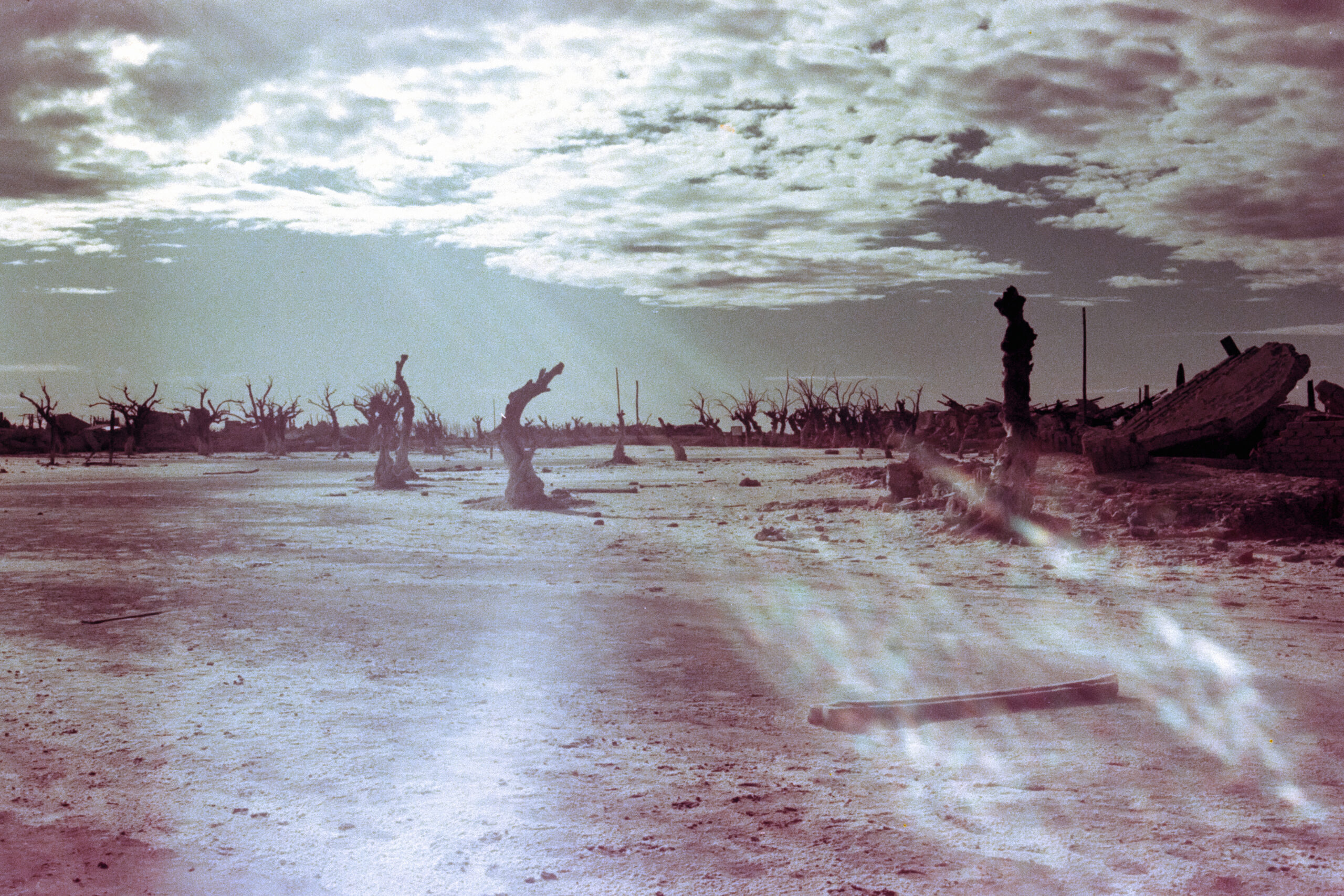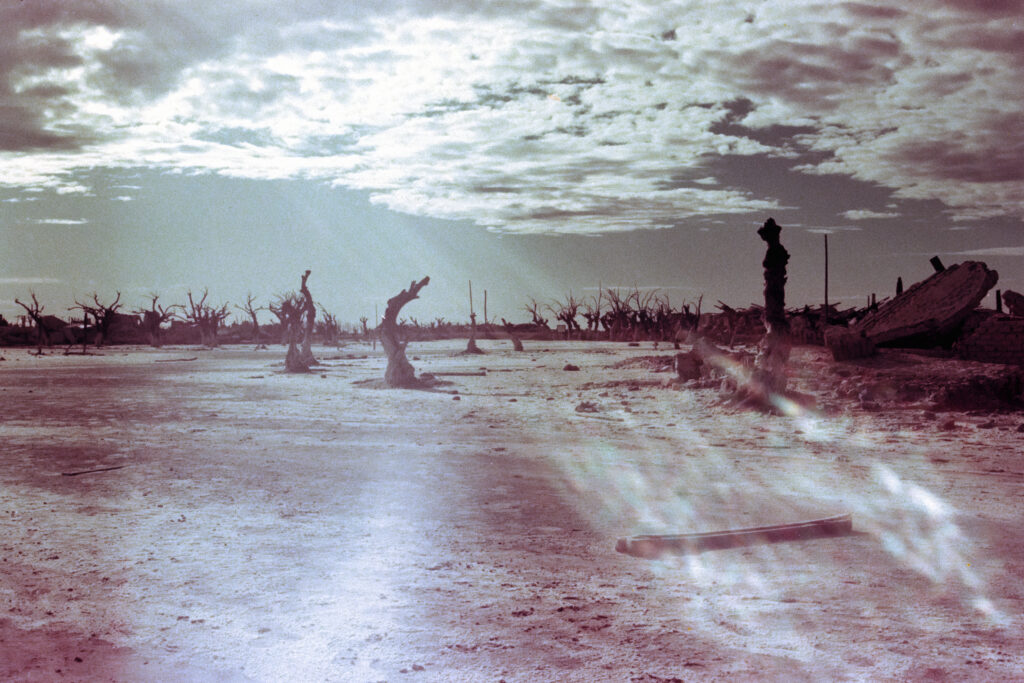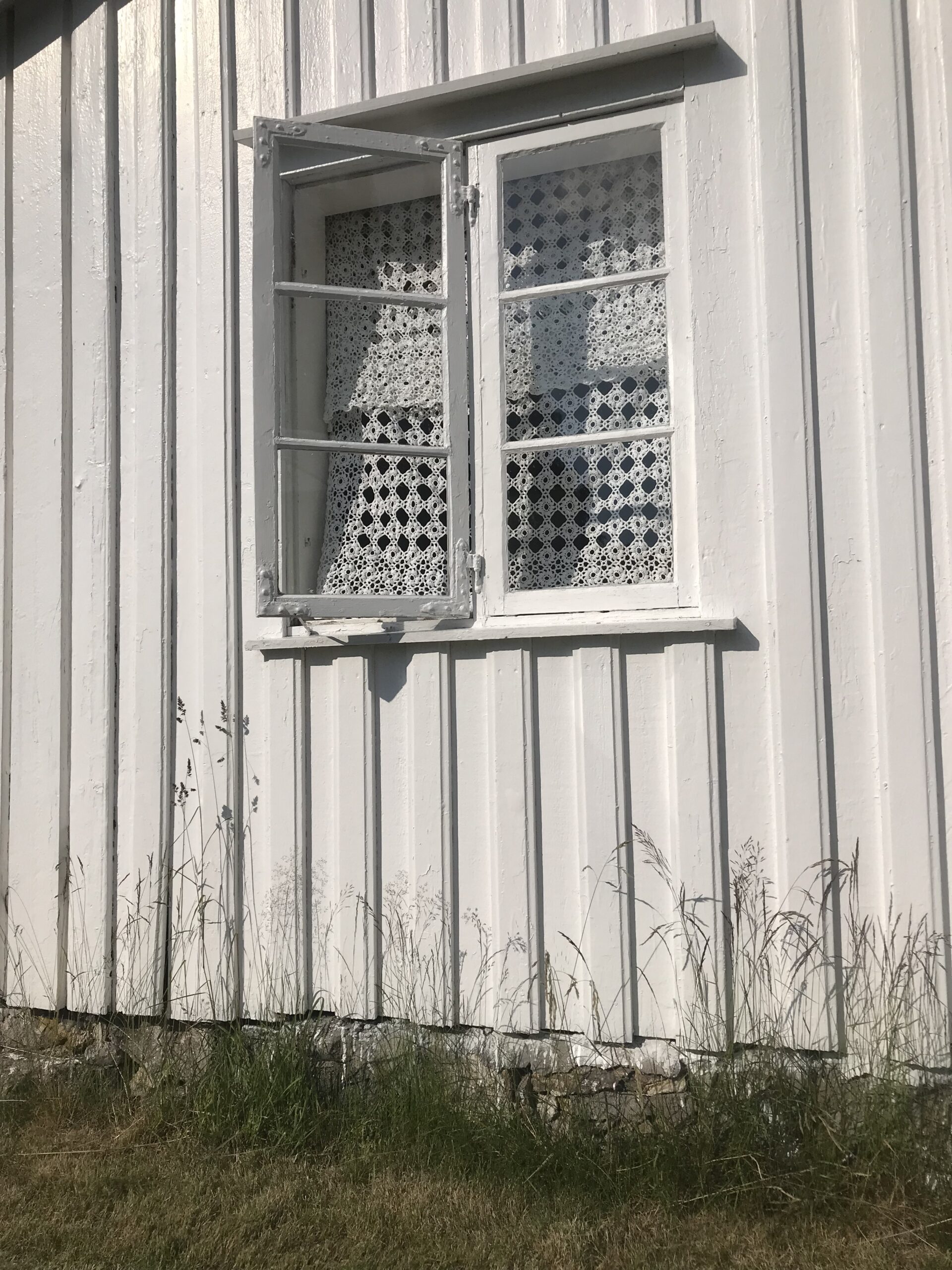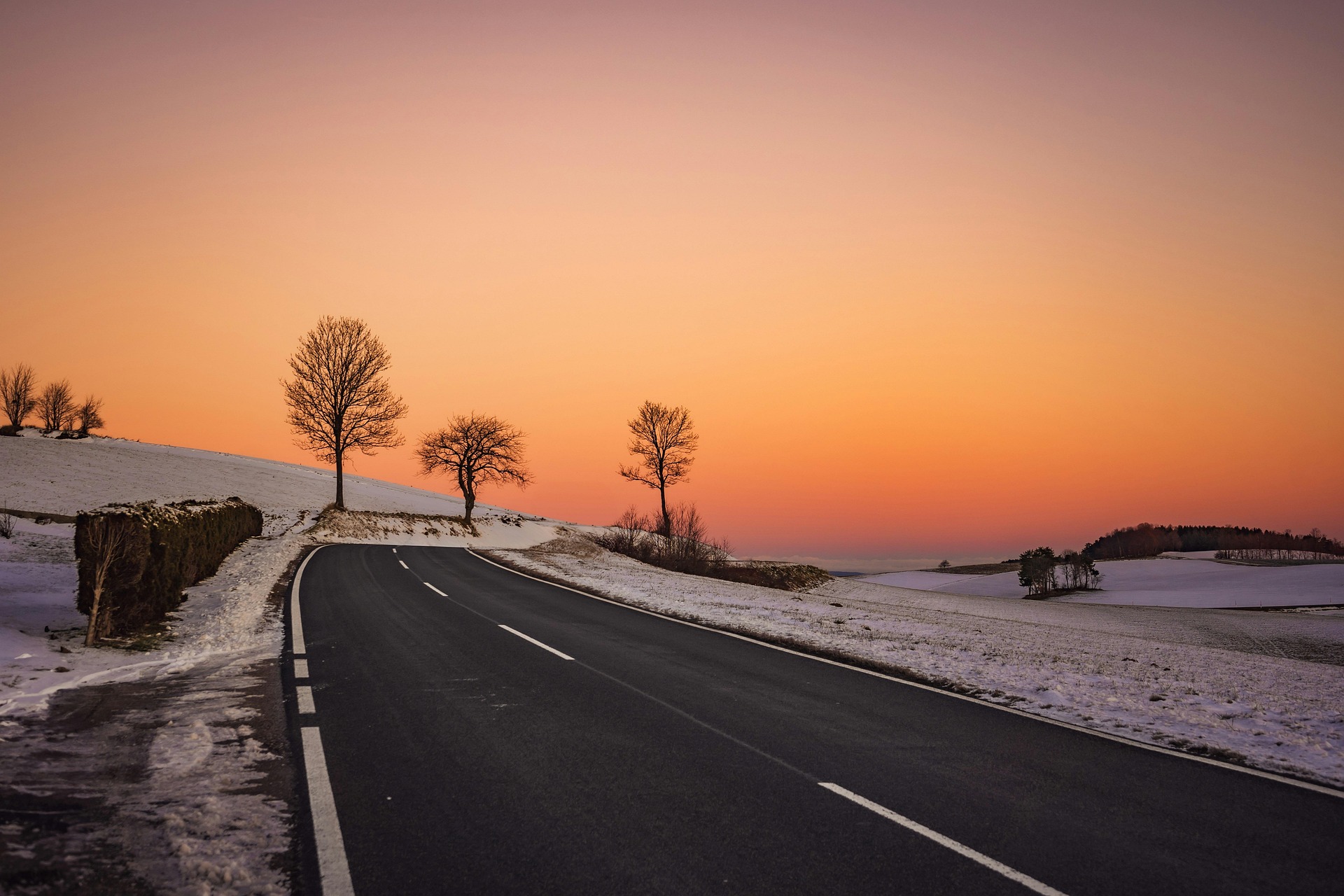“… [C]atastrophe is not something awaiting as in the future, something that can be avoided with well-thought-out strategy. Catastrophe in (not only) its most basic ontological sense is something that always-already happened, and we, the surviving humans, are what remains …. Our normality is by definition post-apocalyptic.”
Slavoj Žižek
Apocalyptica, “From Catastrophe to Apocalypse… and Back”
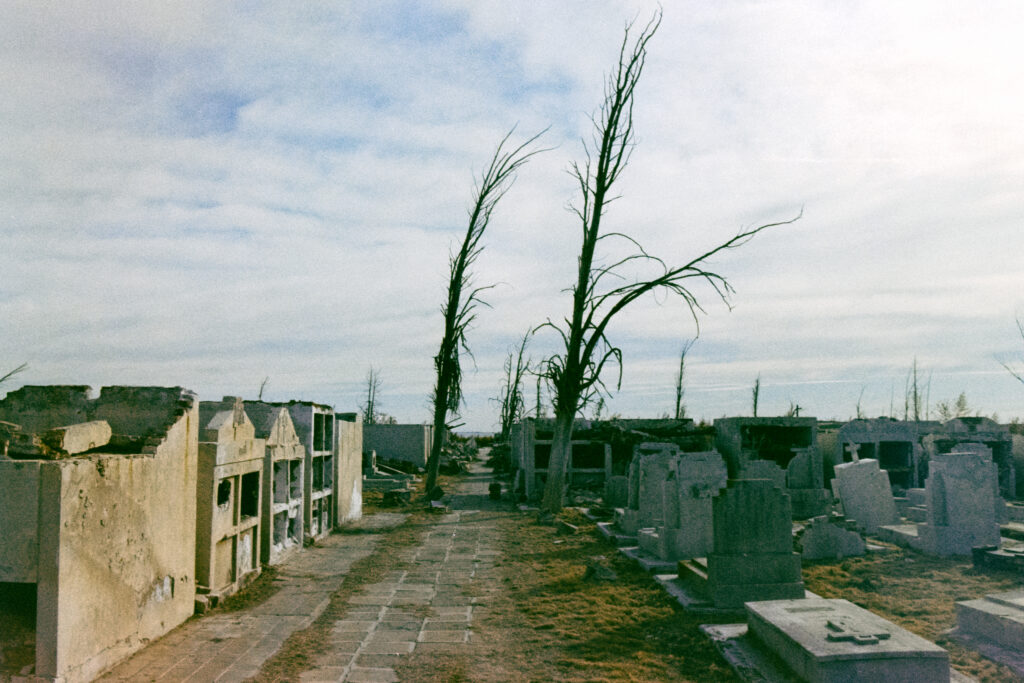
Turntables coated in rust and salt.
Illuminated beneath halogen lamps and stacked on one another like the layers of a wedding cake, the vintage record players boast a thick icing of sodium chloride and iron oxide, the granularity of which almost perfectly emulates the breading of a recently fried chicken finger.
Instead of occupying a warehouse shelf, a basement box, or a landfill, these outdated music makers ended up in a museum display case as witnesses to a singular event that some would define as catastrophic, others tragic, others fascinating. The museum, installed in a train station that hasn’t housed a locomotive for decades, commemorates the flooding and destruction of the town where it is located: Villa Epecuén.
Villa Epecuén was—and continues to be—a small settlement in the middle of the grand Argentine Pampas: an immense, humid prairie with a vastness and flatness that place it among the most fertile stretches of the planet’s arable land. For centuries the Pampas nourished guanacos and cattle, and sprouted fields of wheat and corn. Today it exudes a matted carpet of transgenic soybeans.
As a tourist destination, Villa Epecuén once drew visitors from all over the province and the country. They took baths in the therapeutic waters of Lake Epecuén, on whose shores the town lies; waters whose salinity, like that of the Dead Sea, is ten times greater than that of most of the world’s oceans and seas. Waters that, in 1985, rose fifteen feet, submerging all of Villa Epecuén’s buildings in a briny and muddy alluvium. Only twenty years later did the water level begin to recede, slowly releasing the sunken settlement back to the Pampas with its roofs collapsed, its trees petrified, and its record players deep-fried.
Today, visitors keep coming. But they no longer bathe in the lake; rather, they bask in the ruins.
The motorcycle whose saddlebags I am loading for my trip is, in many respects, a humble acquisition: a little black Suzuki, one of the least powerful and least expensive on the Argentine market. But, for me, it was a personal economic milestone. In a rare streak of luck, I secured a twelve-month contract working as a speechwriter for an executive at a Japanese corporation. It was a brief lull in the endless cycle of breaking even month to month, an anomaly harder and harder to come by in Argentina. I would not get the chance to repeat it.
For years, the idea of visiting the ruins of Epecuén intrigued me. I first saw them in a music video. “It’s not a film set; it’s a real place,” my then-roommate assured me. Eyes glued to his computer screen, we watched a Mad Max-like protagonist armed with a crossbow run through the rubble, evading a mob of gas-masked hunchbacks with bats and axes, all to the tune of Argentine indie rock. I immediately found the apocalyptic landscape fascinating and surreal.
Later, Epecuén came up during my coursework, working toward a geography degree at the University of Buenos Aires. Unencumbered by almost all other natural disasters—earthquakes, landslides, tornados, wildfires—the Argentine Pampas are frequently and repeatedly ravaged by flooding. The causes are not always natural: many floods are aggravated or even directly provoked by the vast network of highways, railways, and irrigation systems built spontaneously and chaotically over the past two centuries. They crisscross the Pampas with no unifying logic or systematization, depositing water where it wouldn’t otherwise flow, or blocking it from where it otherwise would. Epecuén was a clear-cut case study of how a natural occurrence—heavy rainfall—paired with political and engineering shortsightedness can result in social and economic disaster. Long before I got the motorcycle, I had already begun to fantasize about traversing its broken topography, a physical place where both academic catastrophe and sci-fi dystopia could be seen and touched and climbed on.
Now, I’m finally on my way. The sun shines brightly on me, my motorcycle, and the road ahead, but the headwinds are relentless and immediately penetrate the two pairs of pants and three jackets I’ve used to bundle myself. Nothing more quickly chills my excitement for a day behind the handlebars than the cold, but part of a motorcycle’s appeal is the suffering it implies; even short trips on such an uncomfortable and dangerous device demand a minimal degree of stubbornness.
Nudging me forward was another stroke of luck, in a way: Two weeks earlier I had injured myself in a medieval battle, part of a writing group assignment to live a new experience and create a narrative about it. While the battle made for a great ending to my narrative, it also left me unable to fully extend or fully retract my injured leg, my movements limited to permanent hobble. The luck was that my leg had seized up at the ideal angle to manipulate the motorcycle’s gearshift. Still, I start to feel the icy sting of reality about half an hour into the ride, eyes set on covering the three hundred miles that separate Buenos Aires from Epecuén by the end of the day.
Double gloves on each hand are not enough to prevent my fingers from numbing, weakening my grasp on the handlebars and the brake lever. At a gas station, I buy a third pair; the alleviation is, at best, moderate.
After six hours of puttering into the wind, I’ve only covered half the distance. The sun begins to set and the night’s frosty air sweeps in, blanketing the lush plains, but I keep going, piercing the darkness with my low-voltage headlight. Its dull glow barely illuminates the white line in the middle of the road. Unable to see more than ten feet ahead, I tensely hold my course midway between the gravelly shoulder and radiator grilles of the semi-trailer trucks that blast past me from the opposite direction.
The past of Villa Epecuén dates back to what many consider Argentina’s “golden age.” During their three centuries of colonial rule, the Spanish largely disregarded the Argentine Pampas, disappointed by their lack of gold and silver deposits and enslavable populations. Toward the end of the nineteenth century, however, in the wake of Argentine independence, a spike in European demand for commodities—especially beef—paired with the advent of refrigeration made the wheat- and cattle-producing Pampas one of the most prosperous regions on the globe. In the span of a generation, Argentina became South America’s wealthiest nation, and its economy surpassed those of many European imperial powers, including France and Germany. Millions of Europeans—Italians, Spaniards, Germans, Poles, and Welshmen—as well as Armenians, Syrians, Lebanese, and Turks, immigrated en masse in search of fieldwork, doubling the country’s population. French landscapers and Italian architects were contracted to adorn Argentina’s cities with sprawling gardens and grandiose public buildings. “Rich as an Argentine” became a commonly used simile, and Buenos Aires was often referred to as the “Paris of South America.”
It was in this context that Arturo Vatteone, a lawyer turned politician, founded Villa Epecuén in 1921 as a lakeside vacation retreat. Its location at the confluence of two railway lines from Buenos Aires ensured easy access for the country’s monied urbanites.
Argentina started the twenty-first century much differently than it did the twentieth. In December 2001 the country defaulted on its foreign debt. At the time, it was the largest sovereign debt default in modern history; it was also the fourth time Argentina had defaulted in less than twenty years—and two more defaults would eventually follow in 2014 and 2020.
After freezing bank accounts nationwide, the nation’s president, either unwilling or unable to palliate the situation, made known his resignation by simply fleeing the presidential palace by helicopter, flying over the sea of protestors that had by then consumed the streets of Buenos Aires. In the ensuing days, three different replacement presidents duly assumed and resigned the office until a fourth managed to hold his ground. Unable to access cash, for the next year many people resorted to a barter economy, swapping used clothes for food, home appliances for school supplies. Supermarkets and shop owners electrified their storefronts to prevent looting, which happened anyway.
Currency eventually returned to daily commerce when bank accounts were unfrozen, but it was now tainted with inflation (the country had suffered hyperinflation before, and, in the late 1980s and early 1990s, twice changed the national currency because of it). In the early 2000s, annual increases of 20 percent soon climbed to 40 percent, and before long, incumbent administrations pointed to sub-50-percent inflation as the mark of a not-so-bad year. But by 2023 annual inflation hit a high-water mark of 211 percent, rendering salaries nearly worthless and the acquisition of the most basic items—milk, rice, toilet paper—nearly impossible for many.
Save its prestigious universities, what remains of Argentina’s golden age today is mostly limited to the realm of the architectural: palaces, parks, and monuments, some rigorously upkept, others long abandoned. According to the National Institute of Statistics and Censuses (INDEC), currently 38 percent of the country’s population—some seventeen million people—live in poverty. The “rich as an Argentine” aphorism has evolved; now the quip is that Argentina is the only country where one can “go to bed rich and wake up poor.”
The country is rife with ruins, and not only from the golden age. Some are anointed with romantic and mystical qualities. A visit to San Ignacio Miní, for example, one of the seventeenth-century Jesuit missions whose remains pepper the tropical jungles of northeastern Argentina and parts of neighboring Brazil and Paraguay, is touted on an official tourism website as an “experience that invites us to imagine the grandeur of an era.” Other ruins—unfinished hospitals, countless uncompleted block apartments, abandoned but undemolished ministry buildings, among so many others—are more often ignored, ugly signs of the country’s interrupted attempts at progress.
On the outskirts of a sleepy town named Daireaux but pronounced “Dero,” I stop at another gas station to warm my fingers under the bathroom hand dryer. I rub my hands under the hot air for five minutes as others enter and exit, shooting me odd glances while reclasping their belt buckles.
A miscalculated step as I move toward the bathroom door fires an acute bolt of pain through my left knee. I clutch the countertop and brace my weight against it, breathing hard until the pain subsides. Hoping no one will open the door and find me huddled there.
When I finally limp out of the gas station and head back to the bike, a diner leaves his coffee on the table and chases me outside.
“Excuse me, but where are you going?” he calls from behind.
“Epecuén,” I turn to answer. “But tomorrow. Today I’ve had enough. I’ll spend the night in Daireaux.”
“Oh, okay. I wanted to let you know that there are capybaras around here. There are lots of ’em, and they run across the road at night. It can be dangerous, and I wanted to warn you.”
I still have 120 miles to go, but the sincere concern of this absolute stranger assures me that I’m a long way from the big city.
“Hey, babe, tell me you brought the mate,” a man calls out to his girlfriend, extending his cell phone out to take a photo of himself.
The three most common objects in Villa Epecuén today are cell phones (probably the most common object anywhere), baby strollers, and thermoses for drinking yerba mate, Argentina’s national infusion. Currently, some twenty-five thousand tourists visit the ruins every year, the same number of vacationers who flocked here annually in the 1980s, before the flood. Most of them, like me, lodge in Carhué, a neighboring town also on the shores of the lake that—a little larger, a little older, and a little higher—managed to survive the floodwaters. I arrive in Carhué at noon and set up my tent at a campground before climbing back on my motorcycle to cover the remaining three miles to the wrecked village.
A low wire fence encircles the ruins, directing visitors to a turnstile entrance around which vendors and merchants offer the trinkets that tourists from the city usually hanker for when venturing into the countryside: organic honey, cold-pressed olive oil, handmade knives. There are also some local specialties: salts extracted from the lake and a “mud cream” prepared with the clay from the lakebed. An old bus converted into a rustic food truck offers hamburgers, pork sandwiches, and French fries. Inside, after each buying a three-hundred-peso ticket from the municipality, visitors can walk Epecuén’s blighted streets. They are barred from entering its dilapidated buildings, a prohibition that no one obeys.
“I made it onto the roof of that house. And, closer to the lake, I hopped from wall to wall like a ninja,” a leather-clad biker tells me. “I’ve been climbing around here for the past four hours. I love it.”
Despite the incessant selfies and screaming toddlers that concentrate at the entrance, deeper in, the ruins remain calm and tranquil in their gradual disintegration. It’s another cool day, and a radiant sun casts a full white light on amorphous mounds of cement, tile, and rebar. Despite the town’s state of total ruin, it’s wide, dirt streets remain mostly clear, navigable even with a limp. I pass by rusted kitchen sinks and water heaters. Salt covers the earth, glazing crumbled bricks like an early-morning frost typical of other latitudes. The once leafy trees along the sidewalks now hunch over in all directions, branches dismembered, trunks dry and pale, bark wrinkled and callused. Collapsed electrical poles line my path, their cables and fuses eaten away by rust. I pass the fossils of a car: four ashen tires around a splintered chassis and a corroded lump that was once its engine block, splayed out like the delicate shards of a sunken Spanish caravel. Straying from the streets means entering a minefield of wells and septic tanks that, flooded or camouflaged, patiently wait for the errant step of a heedless passerby.
The beginning of the end of Argentina’s golden age was the onset of the Great Depression in 1930, when European economies plummeted and the transatlantic demand for Argentine beef and grain all but disappeared. The country’s response, like that of many others in South America, was to industrialize, or at least to try to, and deploy extensive state-run social security programs. For a time, it worked: while the cash bonanza of the golden age never returned, the manufacturing jobs and welfare state allowed a relatively stable and prosperous middle class to emerge. By the 1960s, the estate owners who had once waded the salty waters of Lake Epecuén had been replaced by factory workers and administrative employees enjoying two weeks of paid annual vacation.
As early as the late 1970s, the lake began to rise. The town’s toilets backed up. Water surged from cracks in its asphalt streets. A brackish puddle formed in the local single-screen movie theater, which led not to its closure but to the ushering of moviegoers to seats farther from the stagnant pool.
Disaster was imminent. In an effort to preserve the seasonal flow of tourists on which Epecuén’s economy depended, residents built a large U-shaped embankment around the lakefront. For a few years, they postponed the inevitable.
On Sunday, November 10, 1985, the lake’s waters poured over the embankment and began to flood the streets. In the course of the following week, Epecuén’s eight hundred permanent residents were evacuated with or without their consent. The provincial government expropriated the entire town and paid evacuees a paltry sum for their destroyed homes. The waters continued to rise for the next eight years; in 1993 they reached their maximum level, more than twenty feet aboveground, swallowing even two-story buildings.
Epecuén’s cemetery, an ostentatious burial ground of marble mausoleums and sculpted cupolas, remained dry that day. The evacuated inhabitants—now refugees in Carhué—gave thanks that their deceased had been saved from the devastation. But after a month, the salty waves reached the corridors of the necropolis, filling its crypts and sending coffins afloat. The former inhabitants of Epecuén organized boat excursions to round up their adrift forebears and tow them to dry land. Depressed and frightened by the haunted appearance of the angels and crucifixes that still loomed over the turbid floodwaters, they decided to smash the tops of the tombs and mausoleums, leaving only their bases hidden underwater. For some reason—shame or humiliation—they did it at night. Little by little, the cemetery was reduced to a cenotaph; its graves emptied and hammered into rubble.
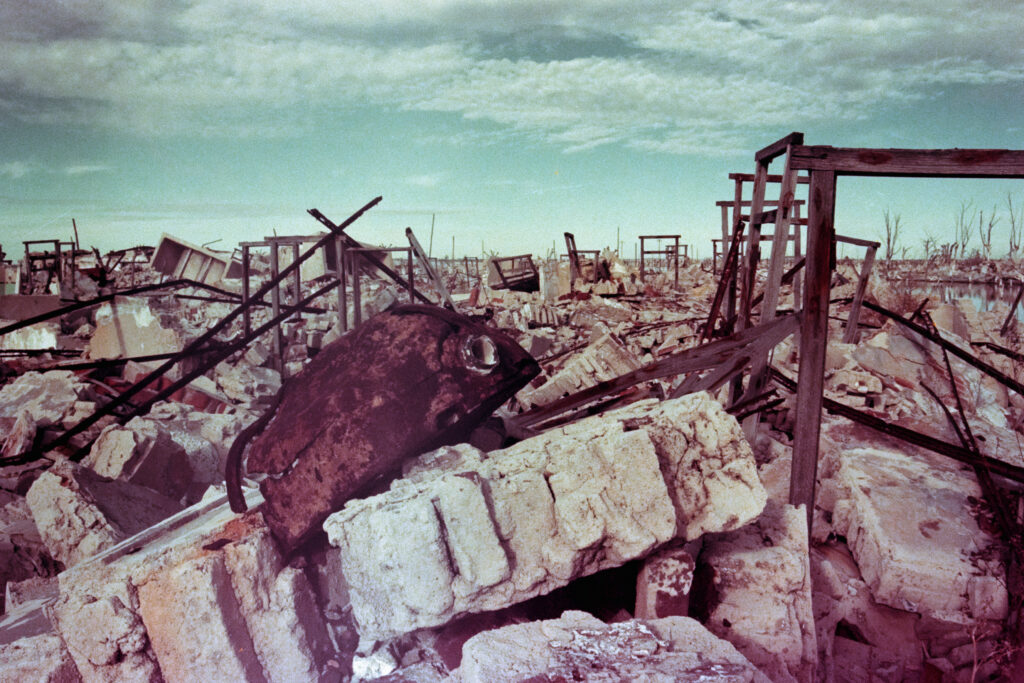
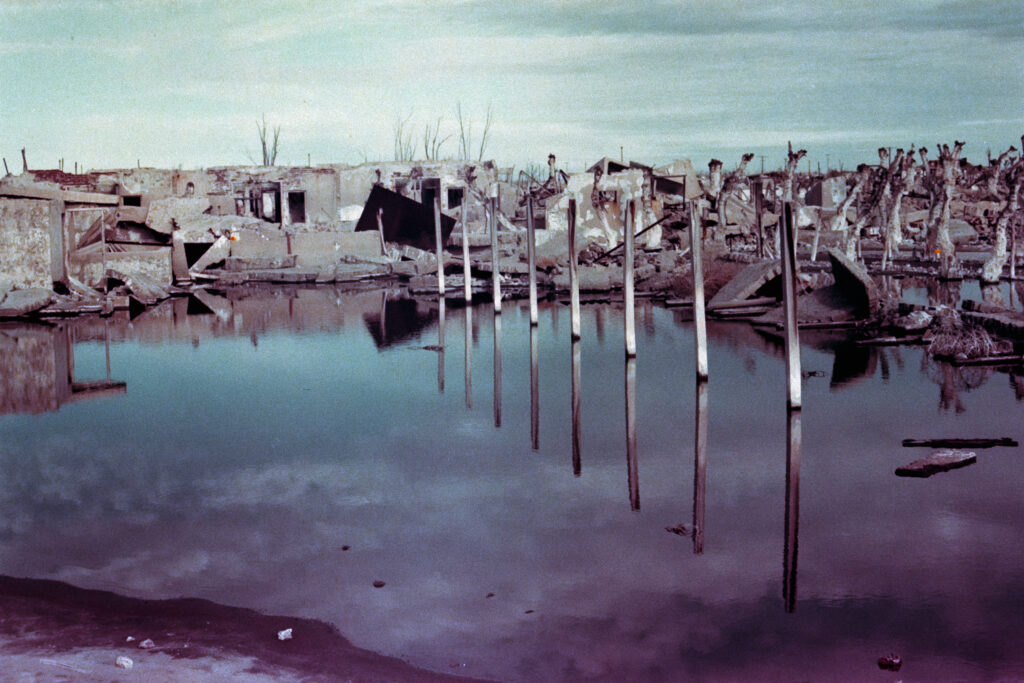
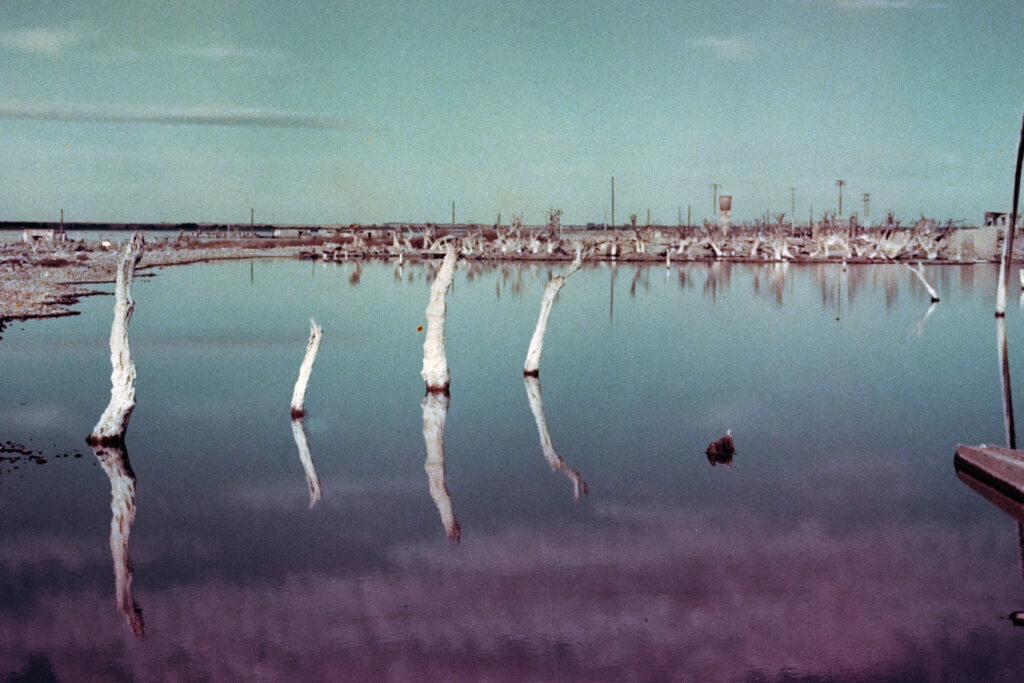
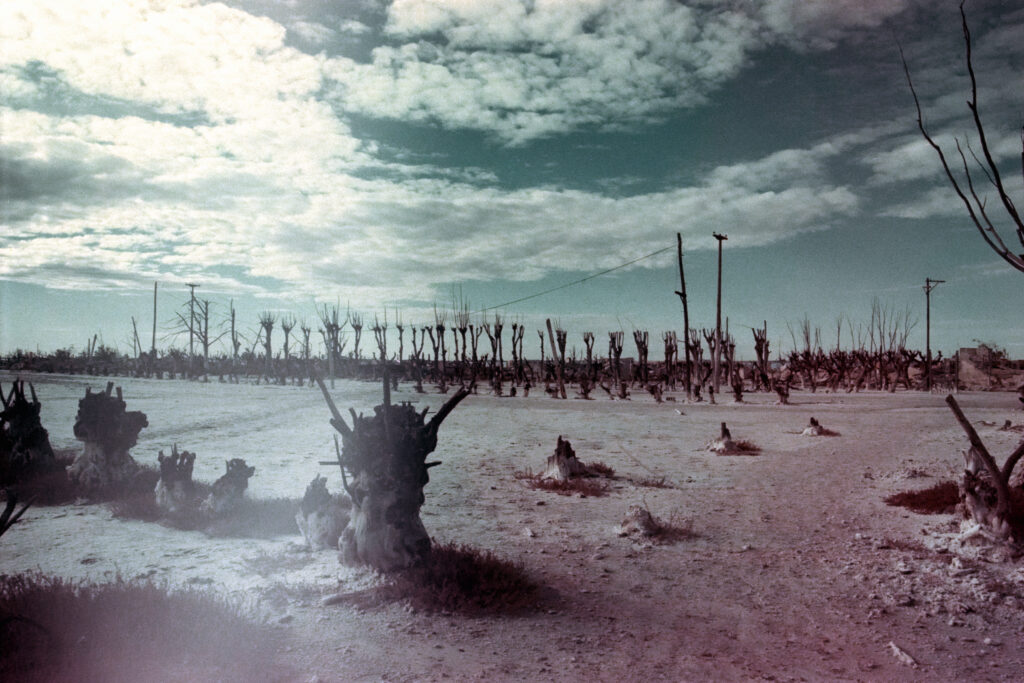
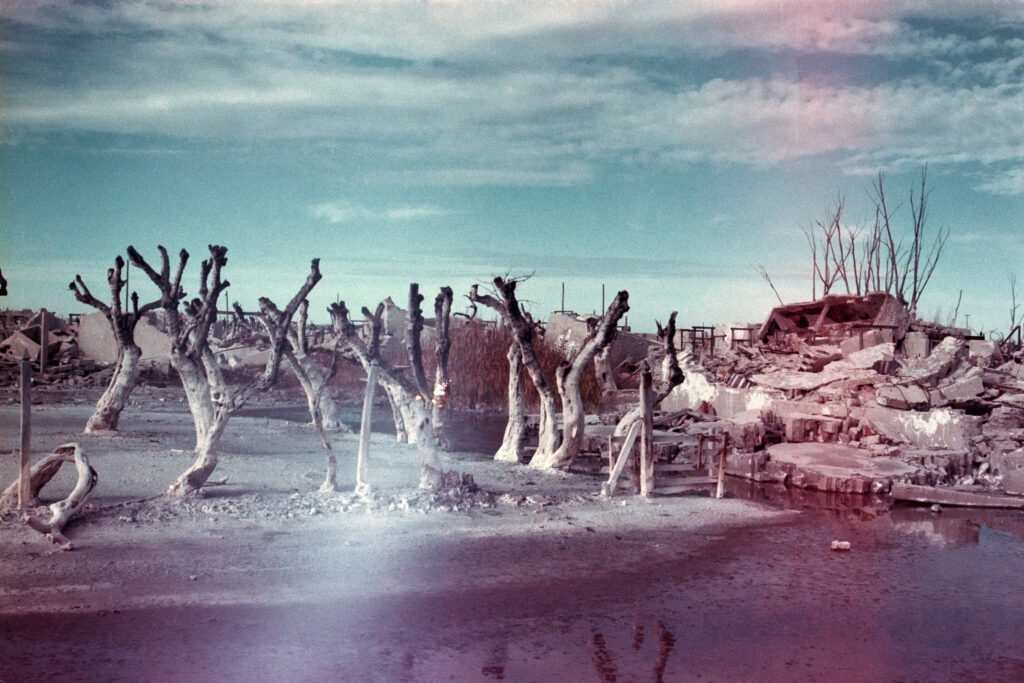
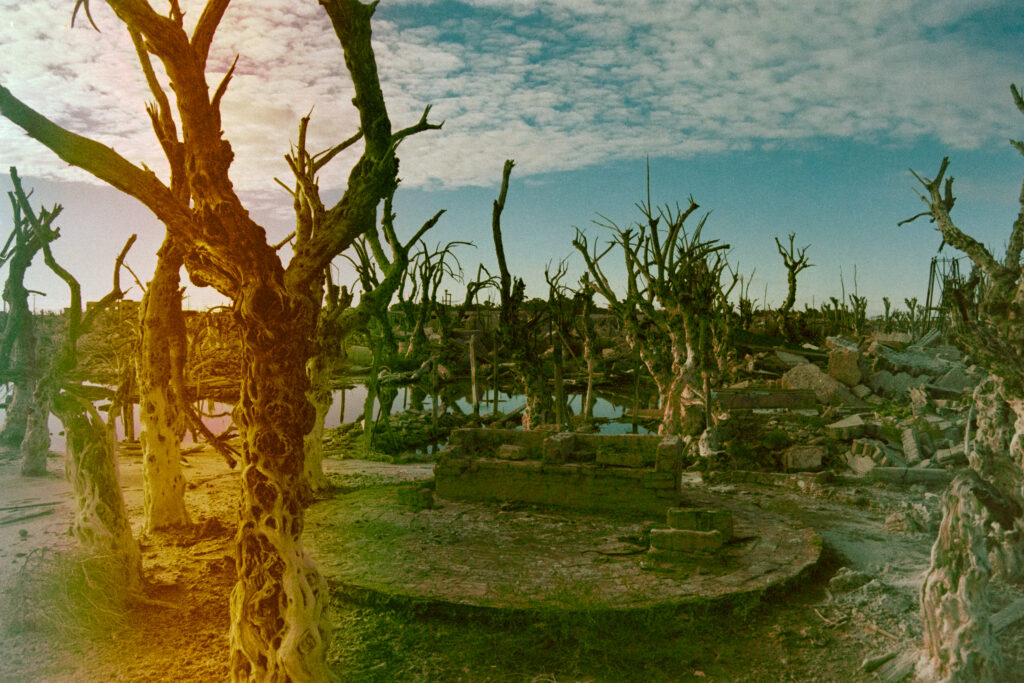
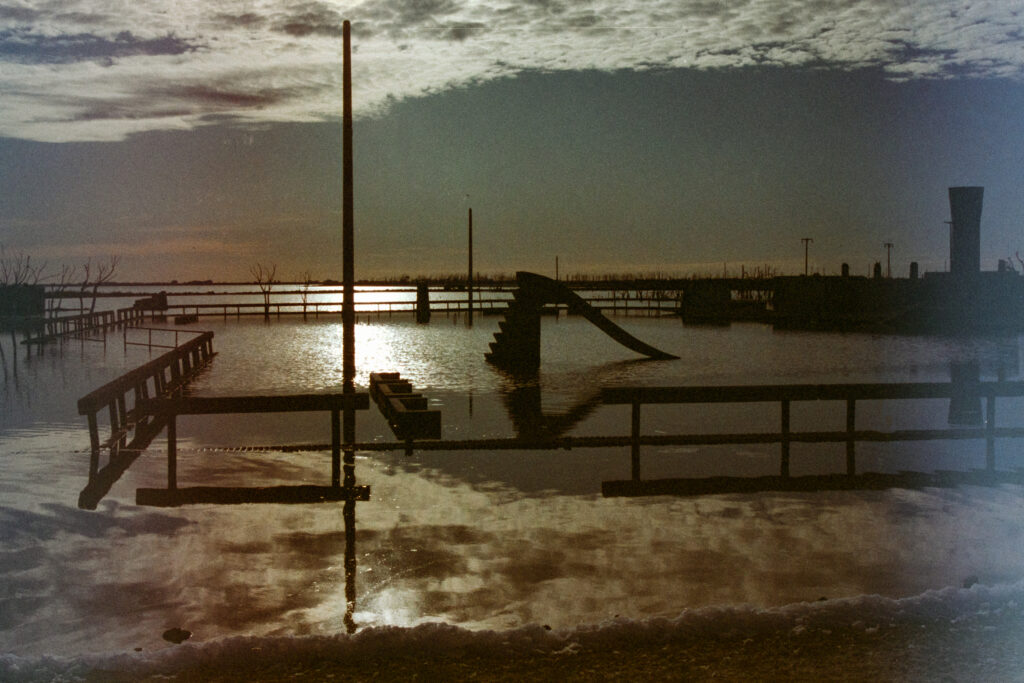
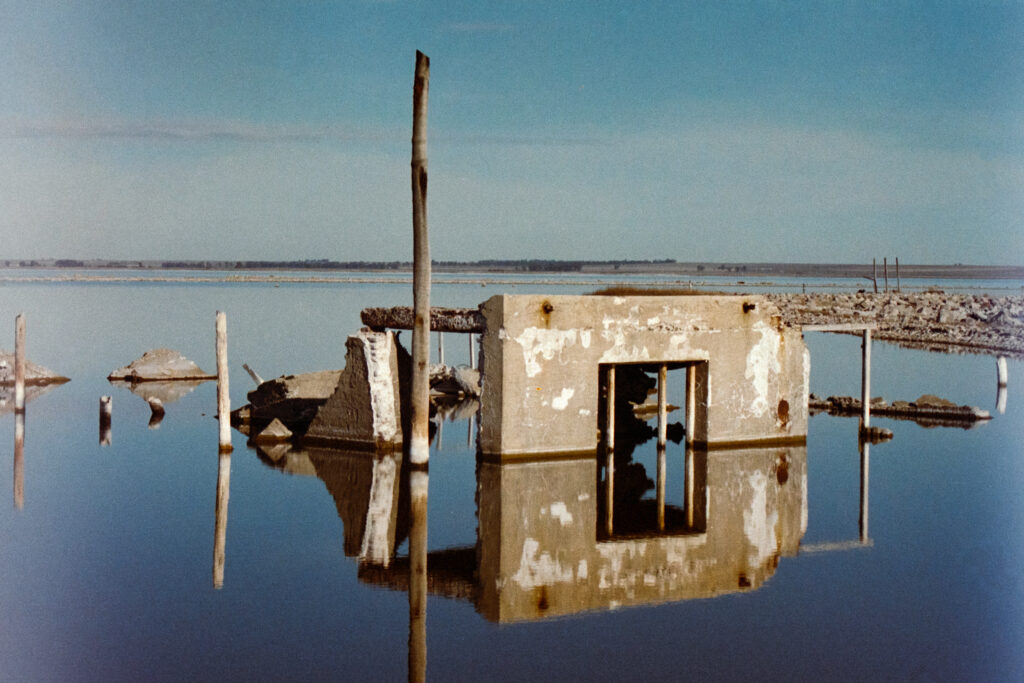
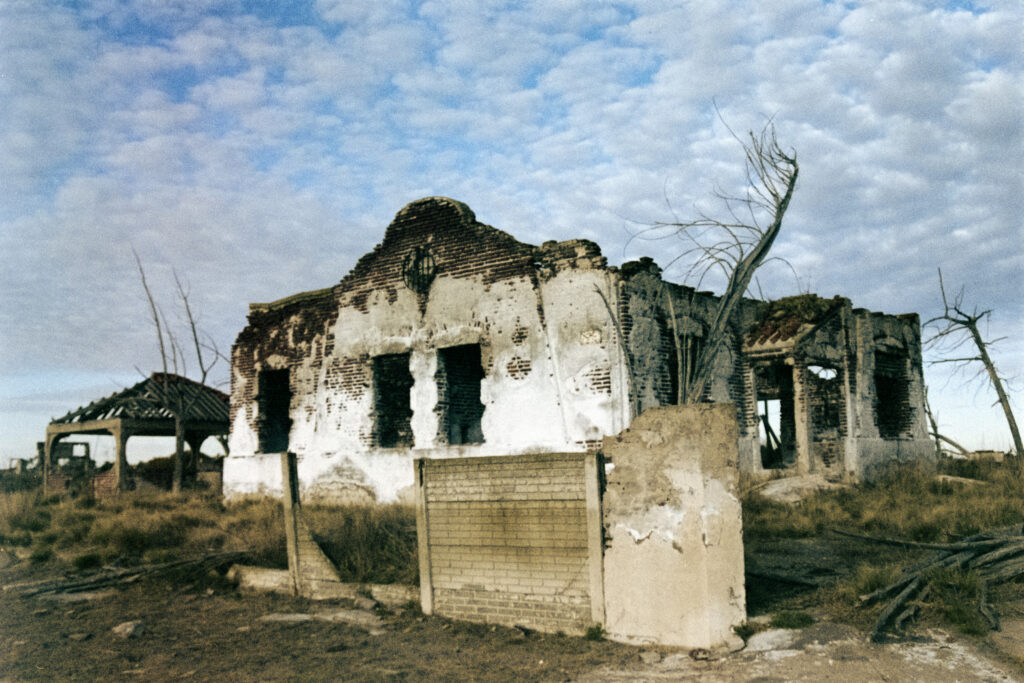
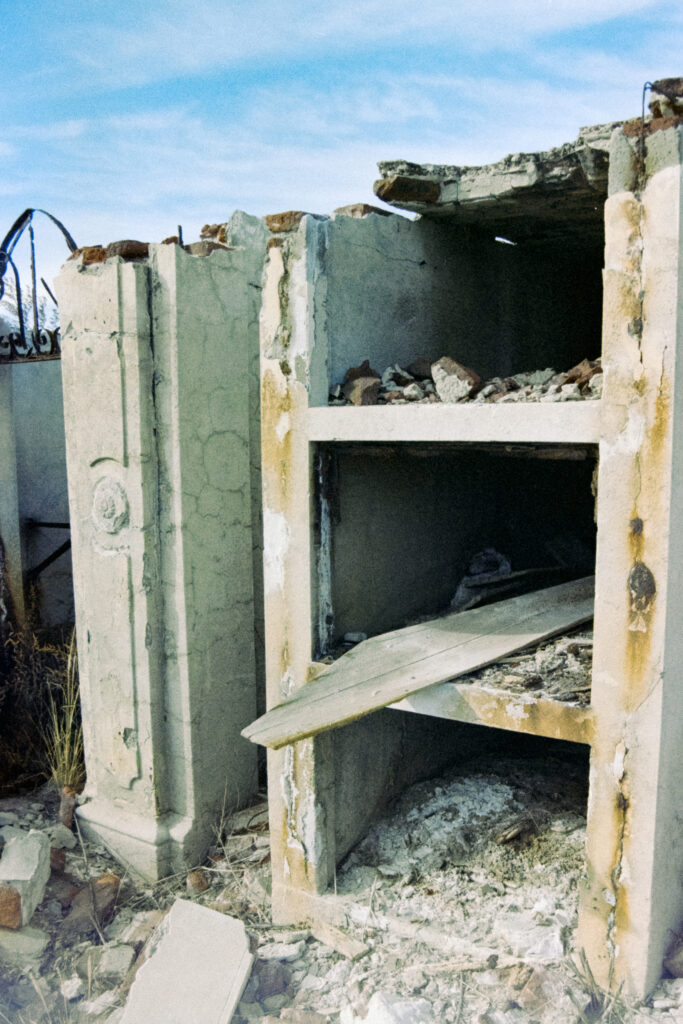
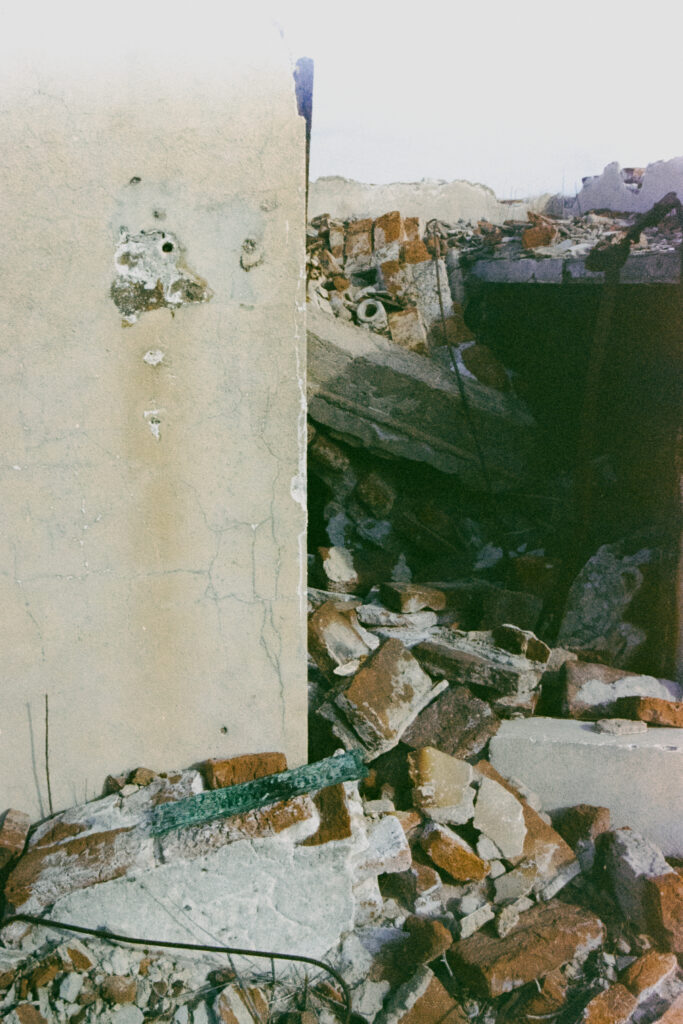
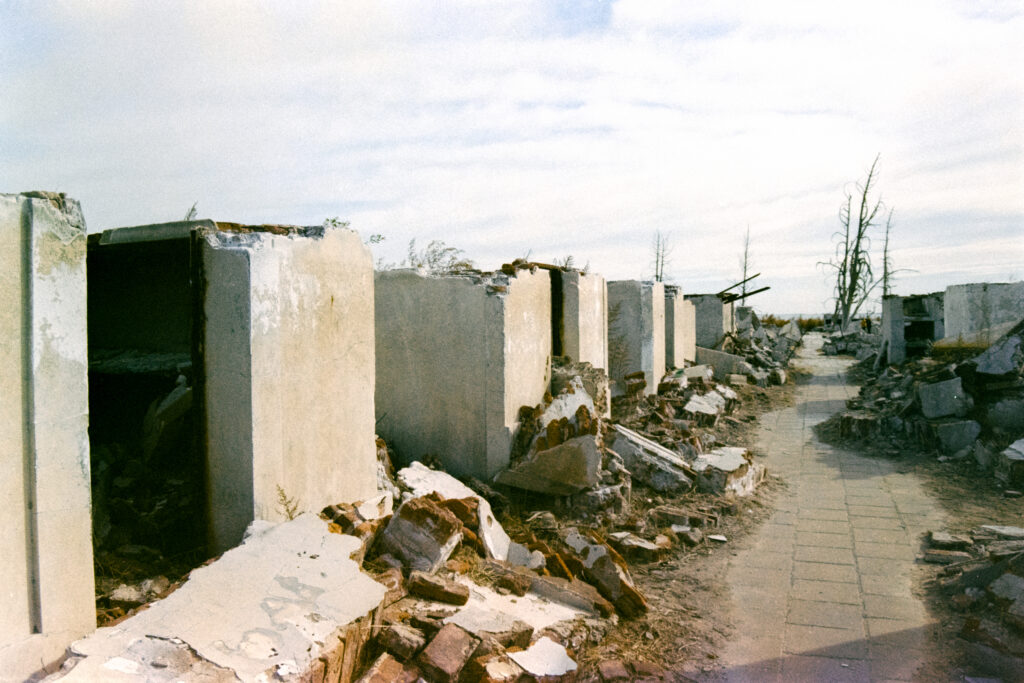
After spending the afternoon tottering through the battered village with my injured leg, then perusing the museum and its record players, I ride back to my tent at the campground in Carhué. Despite its austerity—modest plots of grass for each camper and a communal bathroom—it boasts a heated pool with water pumped in from Lake Epecuén.
When I sink into the water, I immediately feel its abnormal viscosity, the mineral load of sharp crystals in suspension. As I immerse myself, every scrape, sore, and open pore becomes a source of acute burning; the water stings me everywhere. Briefly it draws my attention away from my injured knee, which has grown tight and tense throughout the day, its internal linkage swollen and knotted.
My legs had taken blows before. At nineteen, I thrashed my ankle in an attempt to skate down a hill, the first and last time I mounted a skateboard. I staggered to a nearby gas station to wash off the blood in the bathroom sink. While the wounds scabbed over the next day, I limped for nearly a week; the slightest pressure unleashed waves of pain. But in time, I healed up without ever seeing a doctor. At twenty-eight, a miscalculated swing while chopping wood at a campsite left me with thirteen stitches in the shape of the letter V on my right shin. Once the wound closed, a friend unthreaded them from beneath my skin in the living room of her apartment.
But this time, I’m thirty-three. No easy cure awaits. The German novelist Erich Maria Remarque argues that death begins at birth: that our long journey toward cessation commences at the start of our very being. Instead of reducing existence to this nihilist linearity, I prefer to think of it—for those of us fortunate enough to live relatively healthy lives in relatively healthy bodies in sufficiently peaceful places—as a parabolic curve, split between a youthful ascent that, upon reaching its apex, tapers into a steady decline. Encased in seventy pounds of sheet metal armor, I reached my apex the day of the medieval battle; the pivotal point in which my jovial invulnerability changed course into a slow but steady degeneration. Rather than offering me another colorful anecdote or eccentric scar, this time my injury yielded MRI scans suggesting torn ligaments, a ruptured meniscus, edema: blows only treatable with surgical intervention and never fully reversible.
In the heated pool, the density of the saline waters constantly forces my feet upward, and I clutch the PVC banisters fixed to the pool’s edge to avoid floating away. After a few minutes my skin calms down, but I never stop feeling the tingle of the salts, like a constant caress with the edge of a scalpel. It feels fitting to visit this broken town in a relatively broken state, to acknowledge in one’s own body a rupture that, while it may recede with time, will never return to its former golden age.
The cause of the flood will always be an eternal debate, among the few who bother to debate it. Among the few who lost what little—everything—they had, that Sunday.
In her detailed chronicle of the disaster, El agua mala, the Argentine journalist Josefina Licitra explains that Lake Epecuén is the last in the Encadenadas del Oeste, a system of eight interconnected lakes and lagoons that share overflows and dry spells. Flanked by the eroded remnants of a Precambrian mountain range—the only significant vertical topography among the infinitely flat Argentine Pampas—the system sits within a landlocked watershed. That means every drop of rain that falls on its 6.2 million acres, if not absorbed by the air or the soil, simply stays put. At times of heavy rain, when water levels swell, all excess runs downhill; all overflow pours into Lake Epecuén.
At least, that was how the water behaved naturally. Different human interventions—a relief channel connected to a nearby river (and thus the sea), a series of embankments and gates between lakes—enabled some control over how much water there was, and where. In the 1950s and 1960s, when the lakes were chronically low and dry, engineers sought to make them rise. The last infrastructure project, the Florentino Ameghino canal, was inaugurated a decade before the flood. It cost thirty million dollars and sought to drain some historically inundated fields for sunflower production, yielding a high payoff for a handful of landowners. The floodwaters poured into the Encadenadas del Oeste system. The canal included a gate that opened and closed water flow. It broke shortly after its inauguration and was never fixed.
There’s no doubt about the rain.
In 1984, annual rainfall, which had been averaging between twenty-six and twenty-eight inches, increased to thirty-five, and in 1985 to almost forty-seven. On November 9, eight inches of rainfall in less than twenty-four hours was the coup de grâce. There’s doubt about the Florentino Ameghino canal gate: if it had been fixed, if it had been working. There’s doubt about the relief channel that would have connected the Encadenadas to the sea: if it hadn’t been clogged with earthen bridges tamped by ranch hands to ease crossings. There’s doubt about the provincial and national governments: if they had built additional infrastructure during the five years leading up to the flood, a time during which the region’s hydraulic installations went untouched. And there’s doubt about the inhabitants: if they hadn’t been so reluctant to lose a tourist season. But there’s no doubt about the rain.
After packing up my tent, I prop my leg delicately between the foot support and clutch pedal. I fire the small, whirring engine of my motorcycle and roll out of the campsite. The mantle of clouds covering the windless sky since dawn begins to crack, letting through a few warm rays of sun. Before heading for the highway, I do one last lap along the shore, skidding through the mud and salt. Airplanes loaded with glyphosate herbicide fly above me as I pass through the razed cemetery and stop to admire the calm, mirrored surface of the water. A source first of prosperity and then of destruction, the lake now serenely reflects the blanched skeletons of the dead town. The Argentine anthropologist Gastón Gordillo makes a theoretical distinction between ruins and rubble. Rubble, he proposes, consists of mounds, piles, remains: any broken piece of an abandoned or deteriorated construction once made by human hands. But ruins, he argues, are an abstraction, a staging that transforms unrecognizable rubble into something picturesque, grandiose, and mythical. Rubble is residue, but ruin is fetishization, romanticization, “the attempt to conjure away the void of rubble and the resulting vertigo that it generates.”
On this spectrum, Epecuén falls somewhere in between. The current stream of twenty-five thousand annual visitors enticed by “disaster tourism” equals that of the town’s peak years of spas and thermal baths. Epecuén was never the site of any grand empire or avant-garde historical endeavor; the fractured carcasses of its bakeries, pizzerias, and supermarkets are no different from those found intact and functioning in any other of the hundreds of towns that populate the Argentine Pampas. Epecuén attracts because of its brokenness: a brokenness that extends beyond the town itself, that seems to reflect the Argentine condition as a whole.
It’s hard to pinpoint when Argentina reached its apex, when its bustling rise reverted into the steady degradation and deterioration it suffers today. Some say the Great Depression; others point to any one of the six different coups d’états between 1930 and 1976, or even the more recent 2001 crisis. What is certain is that Epecuén’s ruin coincides with the fall. A vacation resort for the elite turned summer family destination for the working class is today nothing more than a wasteland: fetishized, photographed, but ultimately discarded. Perhaps the fractured cement slabs and twisted rebar of Epecuén manage to make Gastón Gordillo’s theoretical leap from physical rubble to symbolic ruin, from generic debris to nostalgic evocation. But they could never serve as metaphor for any romanticized ideal. Epecuén reflects the bleak horizon the country faces: the fragments of a prosperous past left empty and abandoned, with no one willing or able to reassemble them into any recognizable or serviceable form.
With a slight wince, I press the gearshift pedal. My stomach twists every time I consider the possible interventions the orthopedist could prescribe: shaving a meaty strip of muscle from the back of my thigh to fashion a new ligament, filling my rear meniscus with some sort of synthetic injection, anything that involves a drill. I avoid internet searches of different procedures; the nausea provoked by visual descriptions of slicing, stitching, fusing, and screwing is only surpassed by the unnerving uncertainty of whether I will ever again be able to fully extend my leg. My knee was too swollen and liquid-filled at the time of the MRI to determine the exact nature of the damage. In the meantime, all I can do is wait for the swell to subside, to see what remains intact.
I rev the throttle and ride off toward the highway with the bleak, tattered remains of Epecuén behind me, and the genetically engineered verdure of the soy fields ahead.
Cush Rodríguez Moz is a journalist, translator, and amateur photographer. He holds degrees in history, geography, and journalism. His articles and long-form narrative pieces have also appeared in El Malpensante, Altäir, Relatto, The New Yorker, France 24, and Climática. Having lived in Argentina and Italy, he now resides in Madrid.
